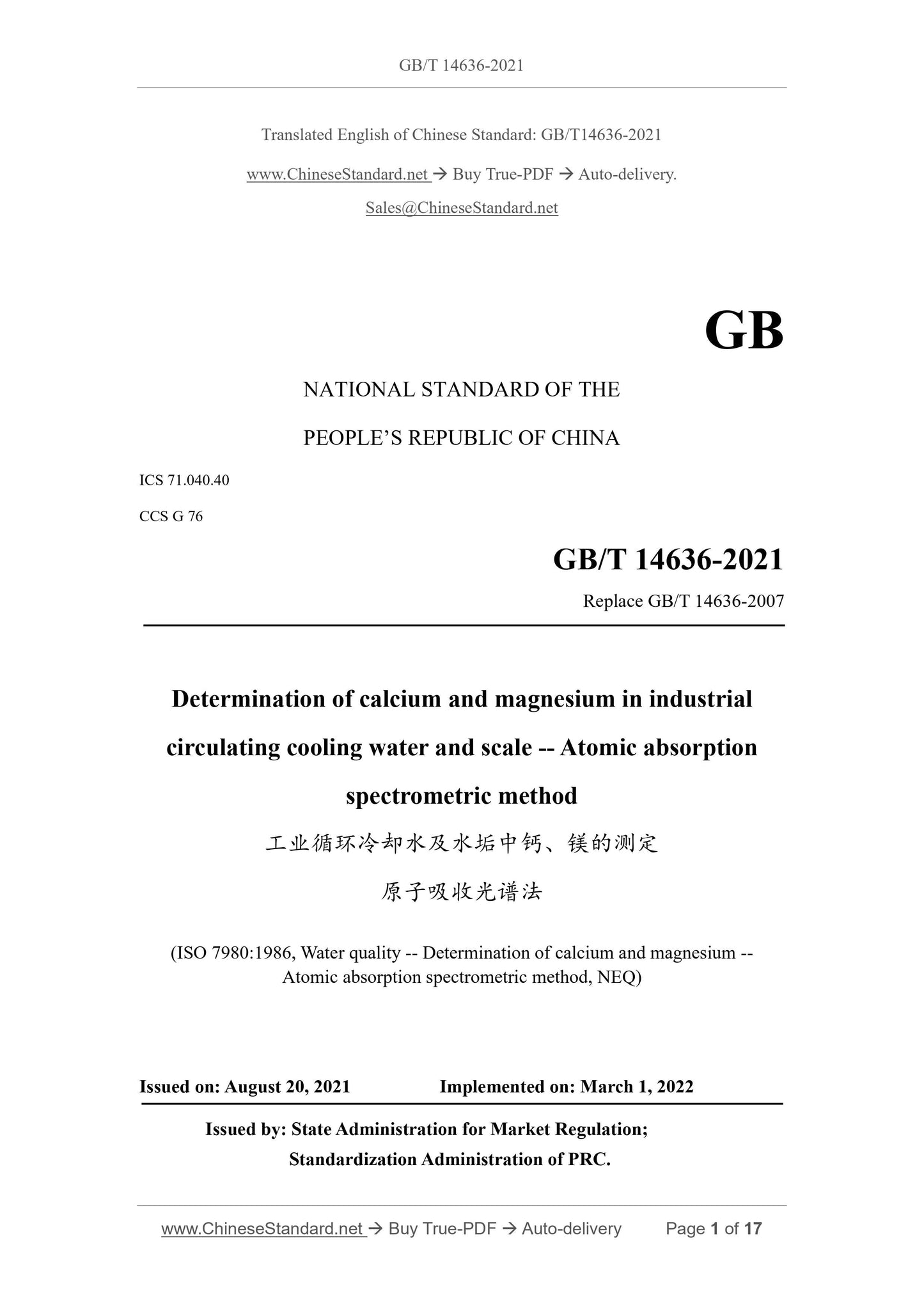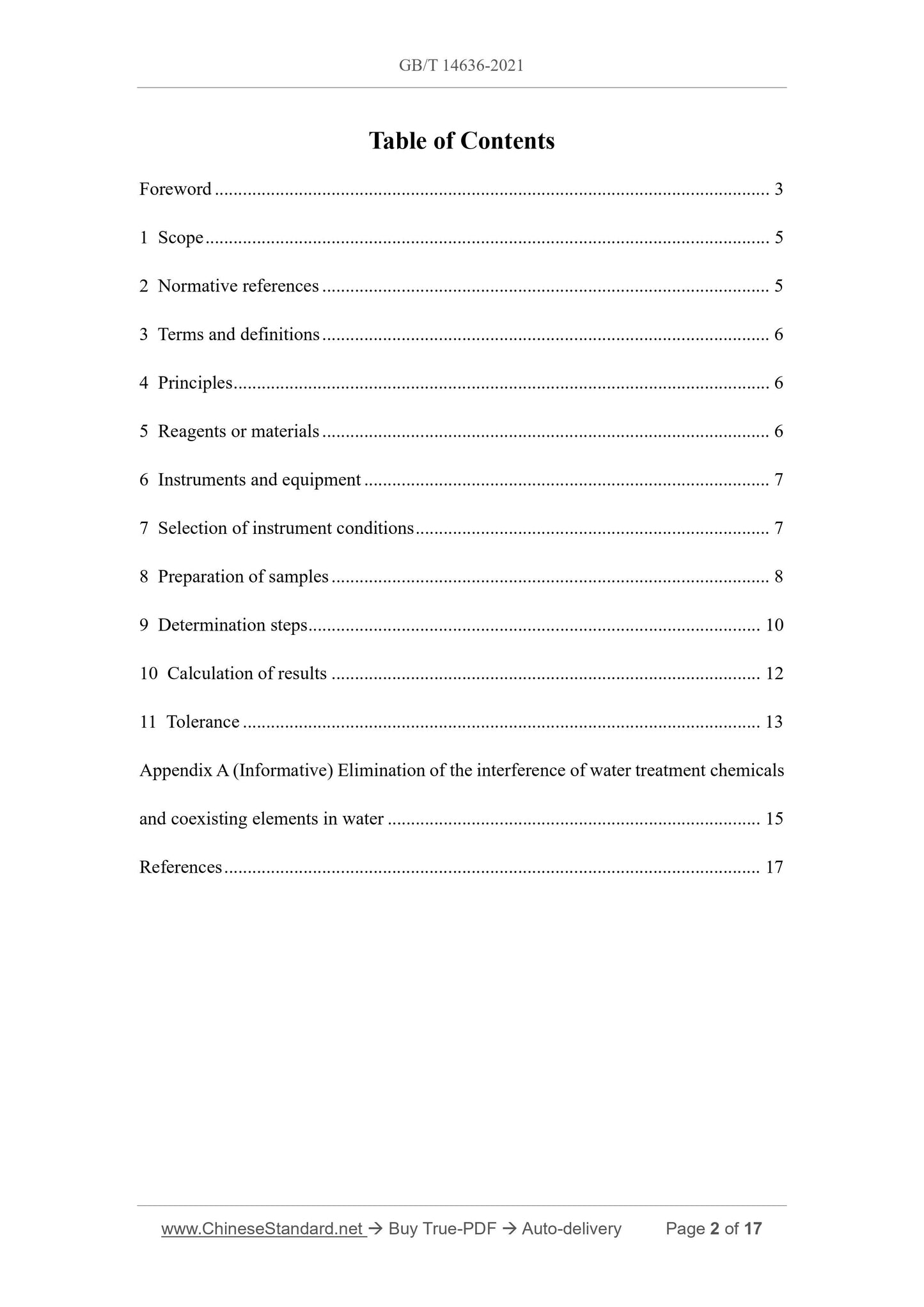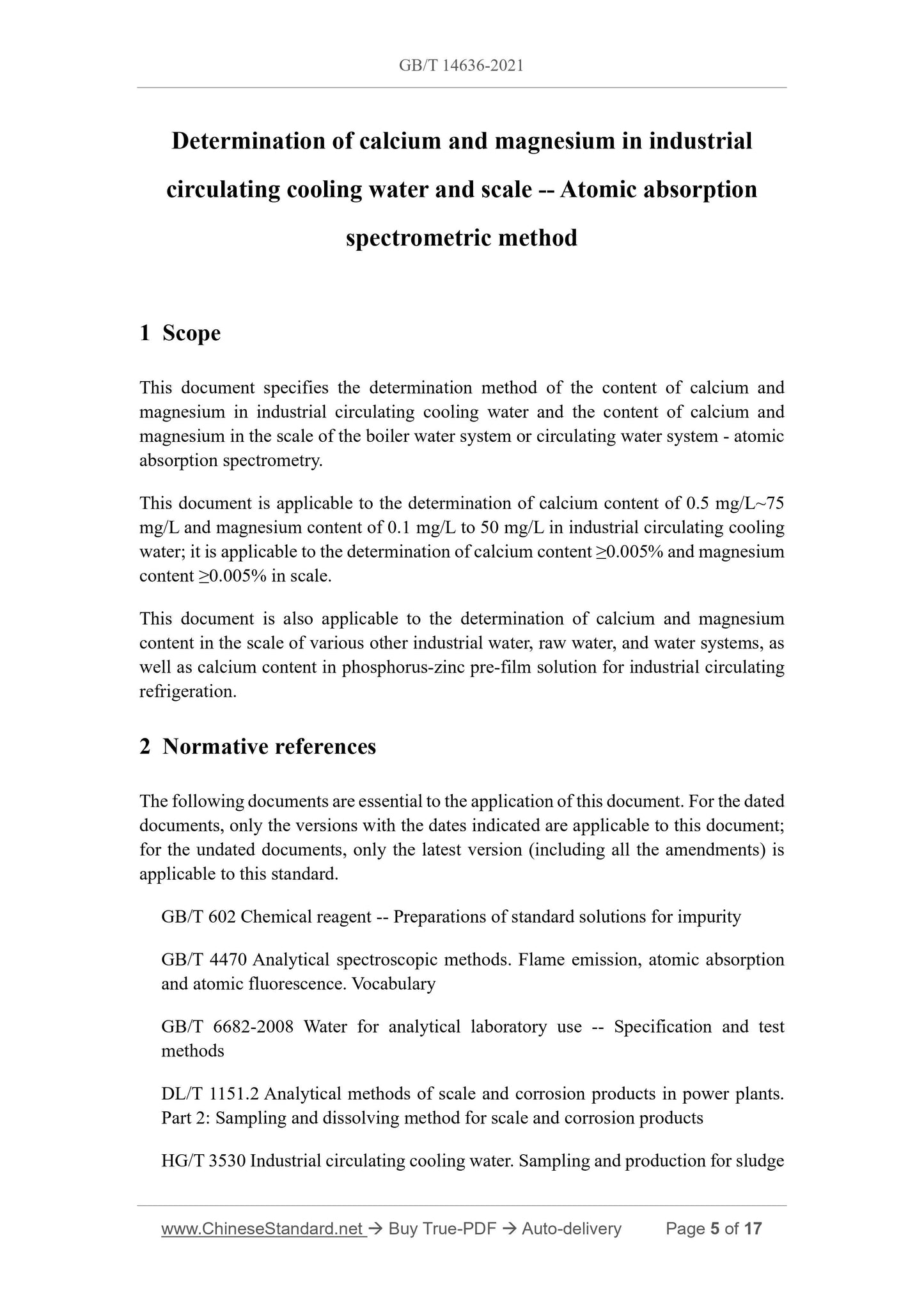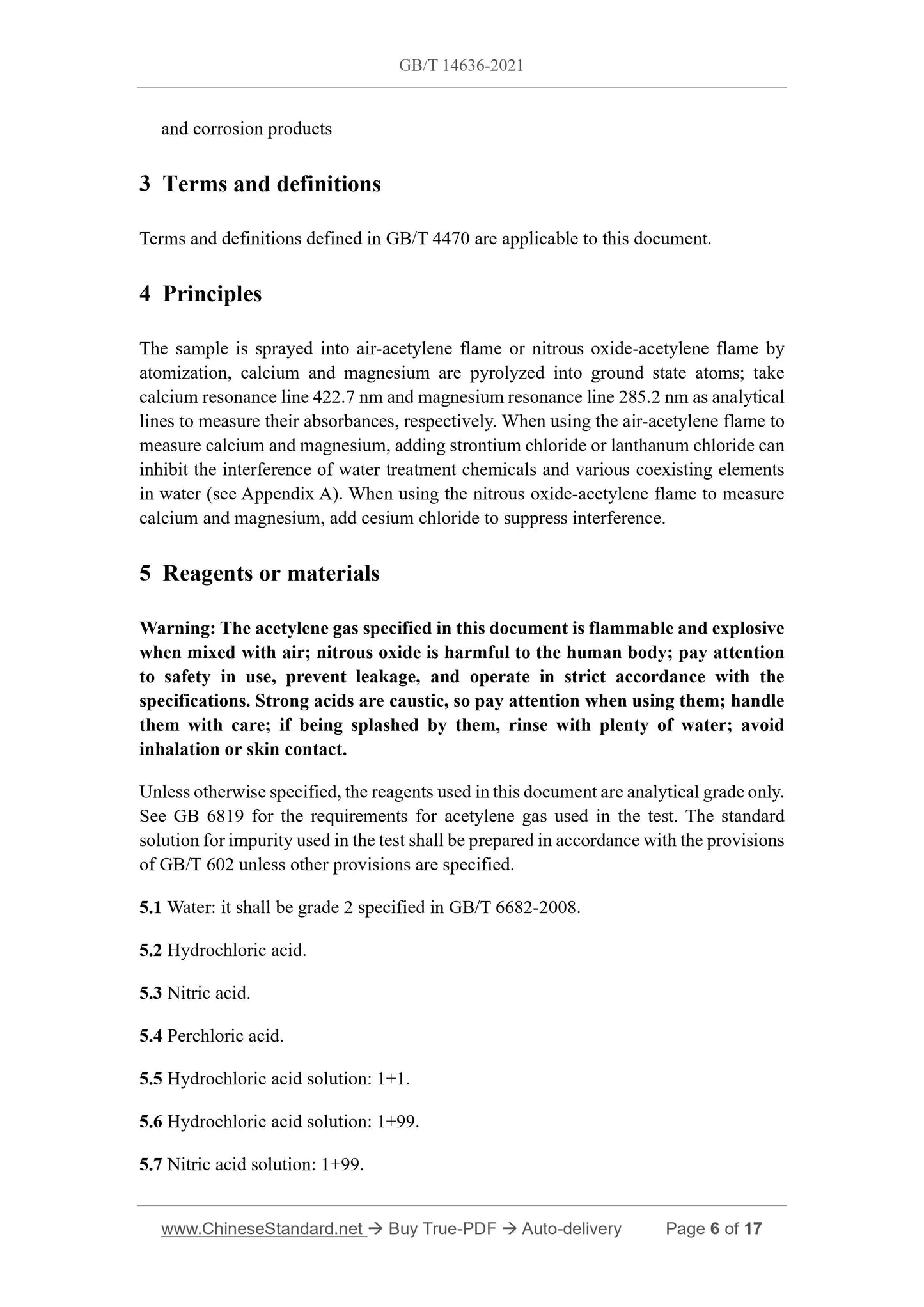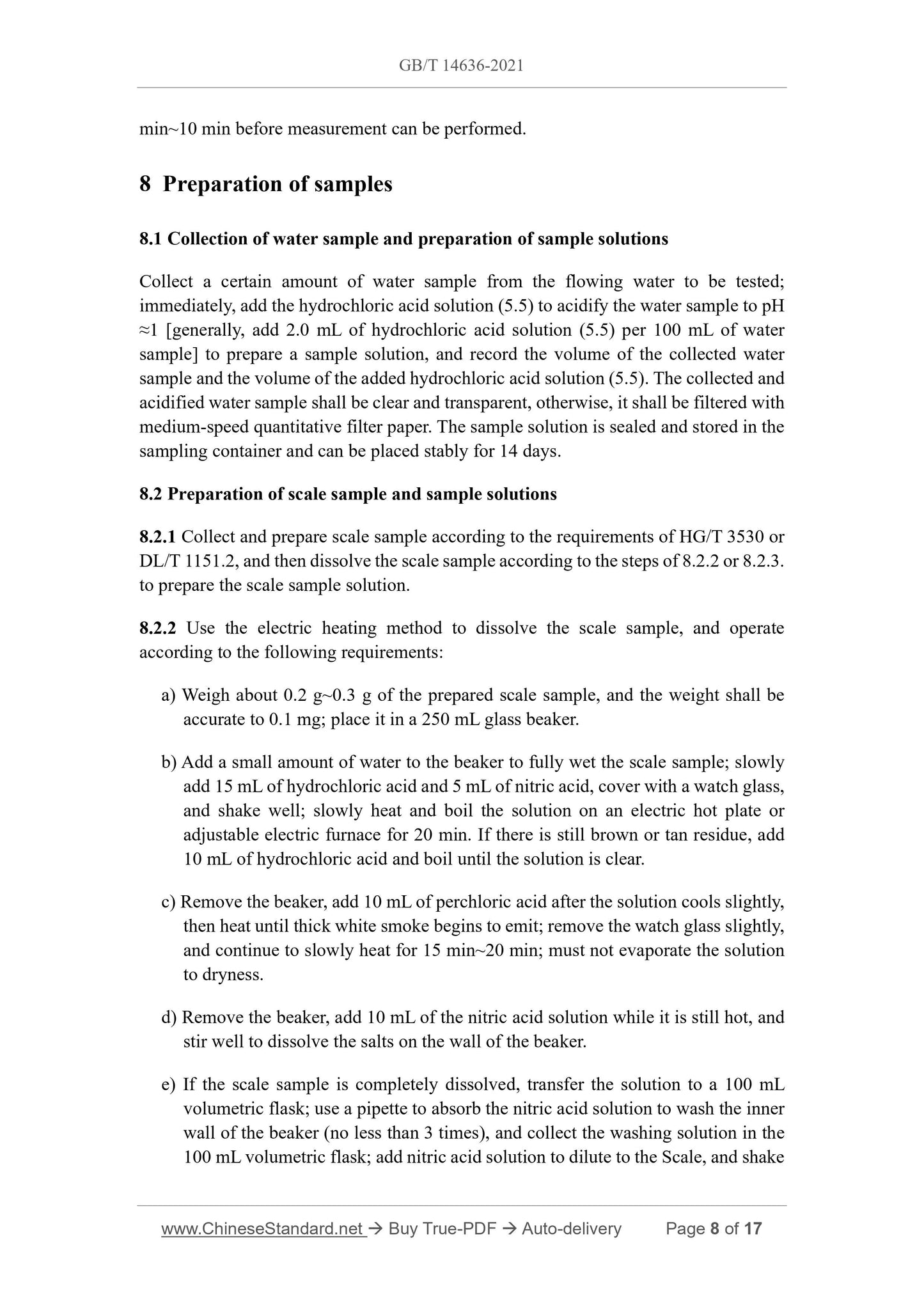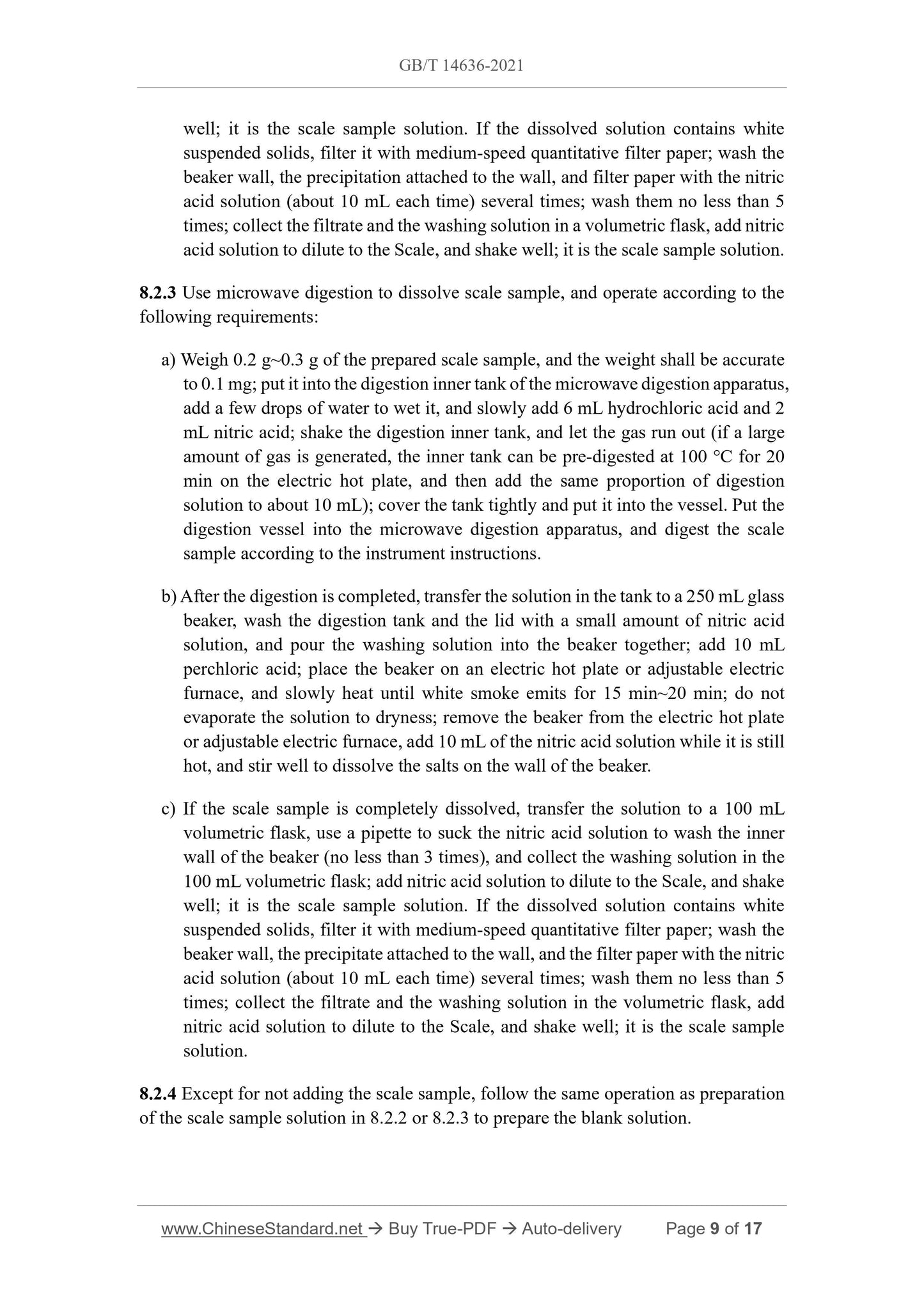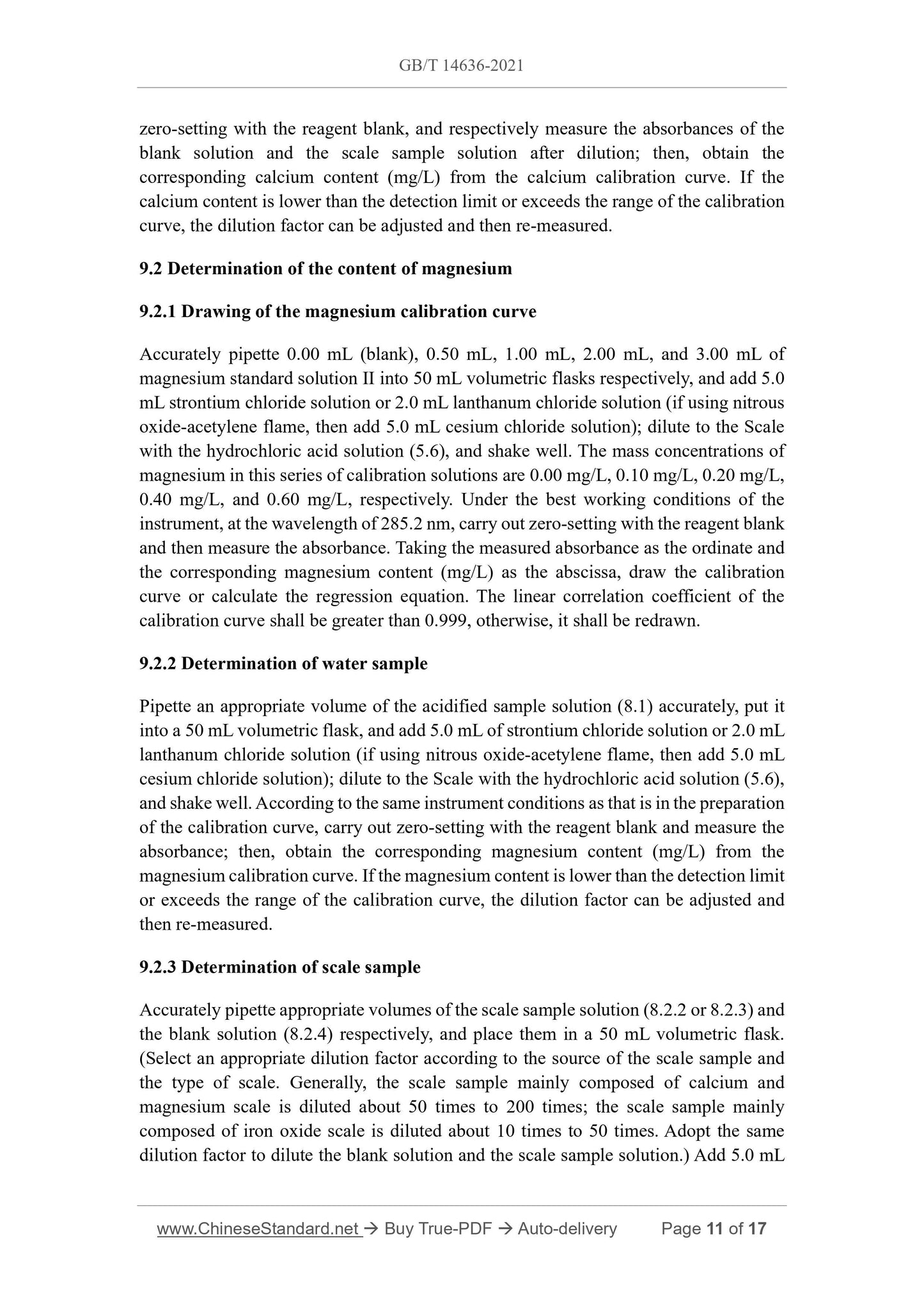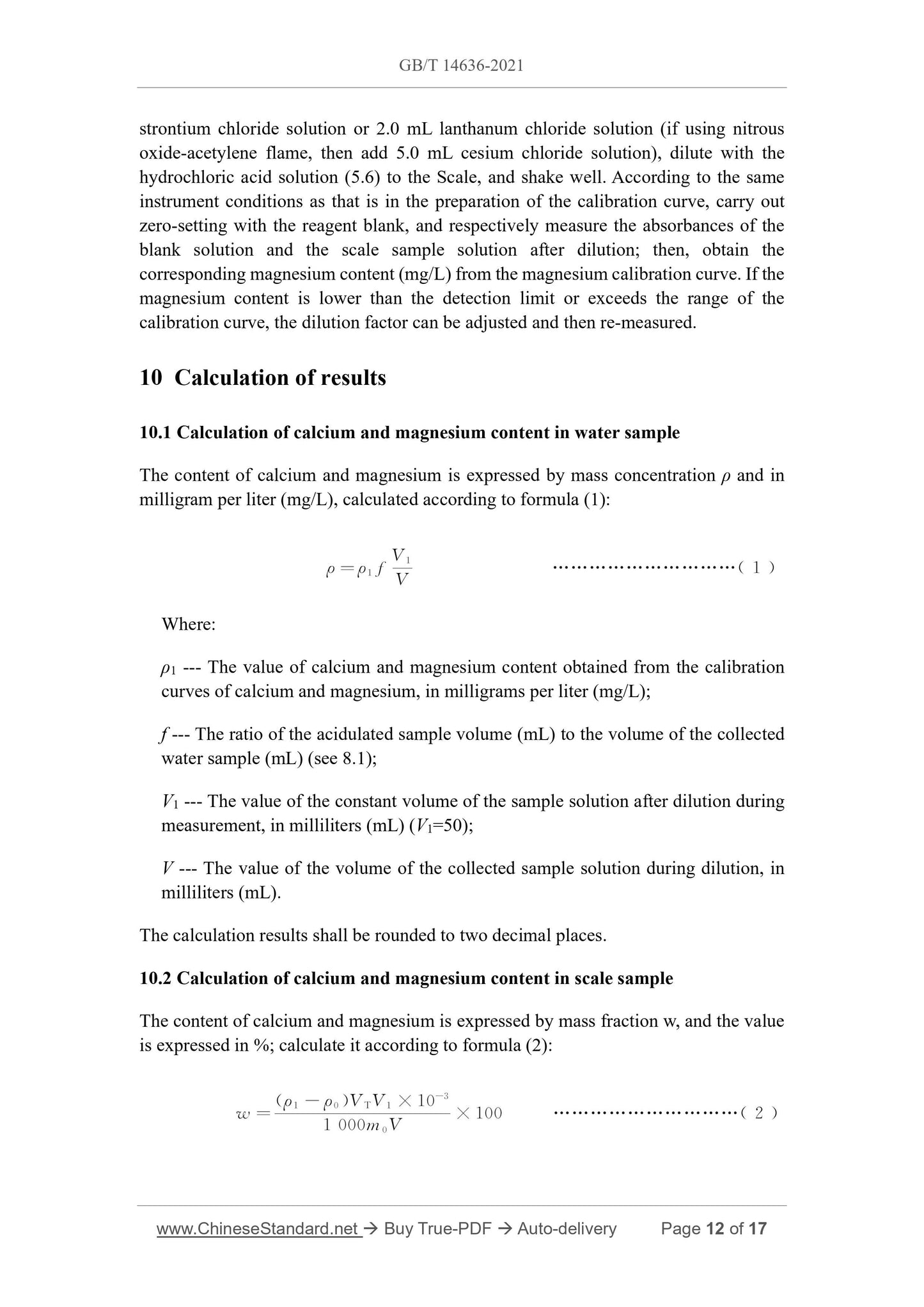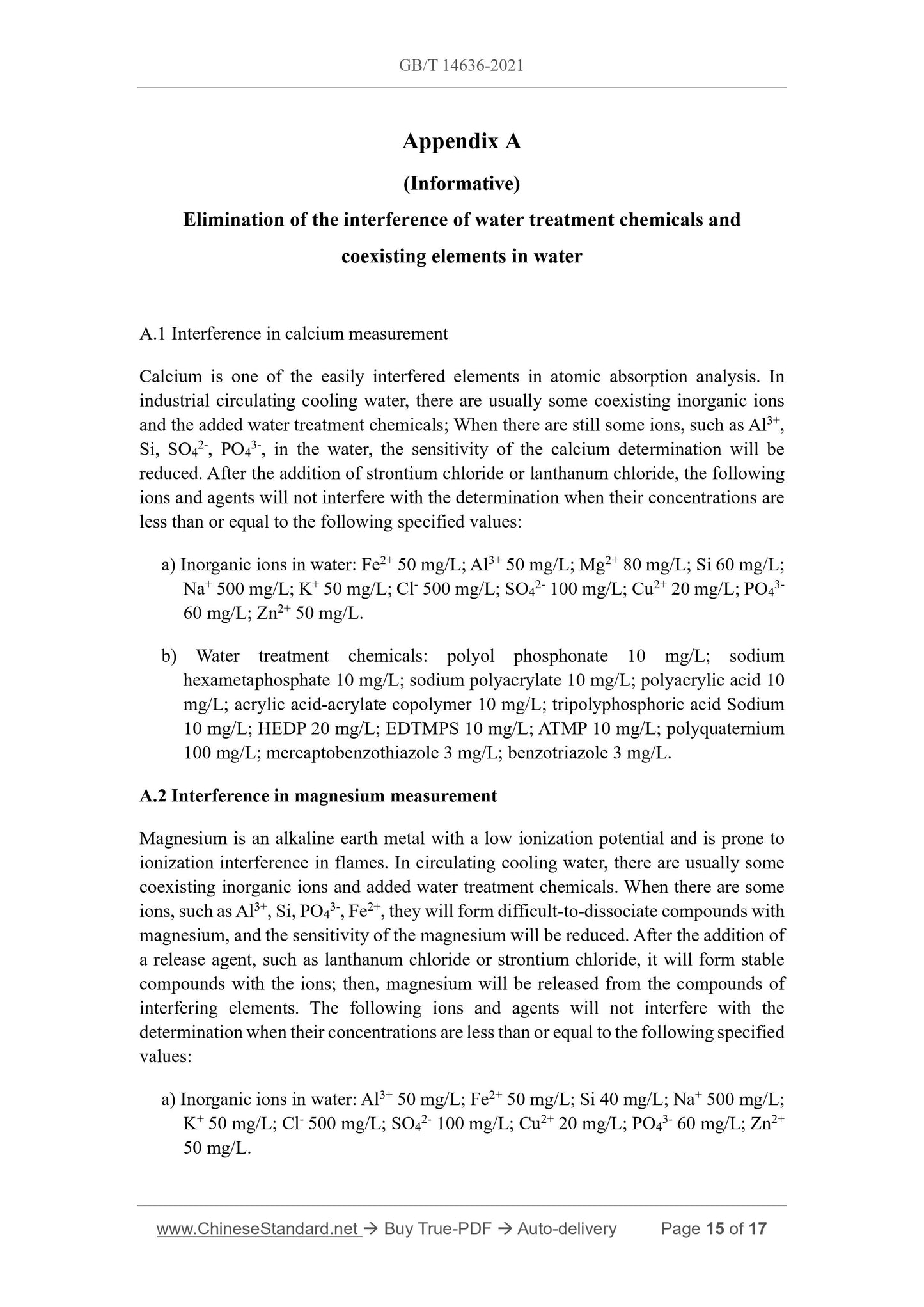1
/
von
9
PayPal, credit cards. Download editable-PDF & invoice In 1 second!
GB/T 14636-2021 English PDF (GBT14636-2021)
GB/T 14636-2021 English PDF (GBT14636-2021)
Normaler Preis
$170.00 USD
Normaler Preis
Verkaufspreis
$170.00 USD
Grundpreis
/
pro
Versand wird beim Checkout berechnet
Verfügbarkeit für Abholungen konnte nicht geladen werden
Delivery: 3 seconds. Download true-PDF + Invoice.
Get QUOTATION in 1-minute: Click GB/T 14636-2021
Historical versions: GB/T 14636-2021
Preview True-PDF (Reload/Scroll if blank)
GB/T 14636-2021: Determination of calcium and magnesium in industrial circulating cooling water and scale -- Atomic absorption spectrometric method
GB/T 14636-2021
NATIONAL STANDARD OF THE
PEOPLE’S REPUBLIC OF CHINA
ICS 71.040.40
CCS G 76
Replace GB/T 14636-2007
Determination of calcium and magnesium in industrial
circulating cooling water and scale -- Atomic absorption
spectrometric method
(ISO 7980:1986, Water quality -- Determination of calcium and magnesium --
Atomic absorption spectrometric method, NEQ)
ISSUED ON: AUGUST 20, 2021
IMPLEMENTED ON: MARCH 1, 2022
Issued by: State Administration for Market Regulation;
Standardization Administration of PRC.
Table of Contents
Foreword ... 3
1 Scope ... 5
2 Normative references ... 5
3 Terms and definitions ... 6
4 Principles ... 6
5 Reagents or materials ... 6
6 Instruments and equipment ... 7
7 Selection of instrument conditions ... 7
8 Preparation of samples ... 8
9 Determination steps ... 10
10 Calculation of results ... 12
11 Tolerance ... 13
Appendix A (Informative) Elimination of the interference of water treatment chemicals
and coexisting elements in water ... 15
References ... 17
Determination of calcium and magnesium in industrial
circulating cooling water and scale -- Atomic absorption
spectrometric method
1 Scope
This document specifies the determination method of the content of calcium and
magnesium in industrial circulating cooling water and the content of calcium and
magnesium in the scale of the boiler water system or circulating water system - atomic
absorption spectrometry.
This document is applicable to the determination of calcium content of 0.5 mg/L~75
mg/L and magnesium content of 0.1 mg/L to 50 mg/L in industrial circulating cooling
water; it is applicable to the determination of calcium content ≥0.005% and magnesium
content ≥0.005% in scale.
This document is also applicable to the determination of calcium and magnesium
content in the scale of various other industrial water, raw water, and water systems, as
well as calcium content in phosphorus-zinc pre-film solution for industrial circulating
refrigeration.
2 Normative references
The following documents are essential to the application of this document. For the dated
documents, only the versions with the dates indicated are applicable to this document;
for the undated documents, only the latest version (including all the amendments) is
applicable to this standard.
GB/T 602 Chemical reagent -- Preparations of standard solutions for impurity
GB/T 4470 Analytical spectroscopic methods. Flame emission, atomic absorption
and atomic fluorescence. Vocabulary
GB/T 6682-2008 Water for analytical laboratory use -- Specification and test
methods
DL/T 1151.2 Analytical methods of scale and corrosion products in power plants.
Part 2: Sampling and dissolving method for scale and corrosion products
HG/T 3530 Industrial circulating cooling water. Sampling and production for sludge
and corrosion products
3 Terms and definitions
Terms and definitions defined in GB/T 4470 are applicable to this document.
4 Principles
The sample is sprayed into air-acetylene flame or nitrous oxide-acetylene flame by
atomization, calcium and magnesium are pyrolyzed into ground state atoms; take
calcium resonance line 422.7 nm and magnesium resonance line 285.2 nm as analytical
lines to measure their absorbances, respectively. When using the air-acetylene flame to
measure calcium and magnesium, adding strontium chloride or lanthanum chloride can
inhibit the interference of water treatment chemicals and various coexisting elements
in water (see Appendix A). When using the nitrous oxide-acetylene flame to measure
calcium and magnesium, add cesium chloride to suppress interference.
5 Reagents or materials
Warning: The acetylene gas specified in this document is flammable and explosive
when mixed with air; nitrous oxide is harmful to the human body; pay attention
to safety in use, prevent leakage, and operate in strict accordance with the
specifications. Strong acids are caustic, so pay attention when using them; handle
them with care; if being splashed by them, rinse with plenty of water; avoid
inhalation or skin contact.
Unless otherwise specified, the reagents used in this document are analytical grade only.
See GB 6819 for the requirements for acetylene gas used in the test. The standard
solution for impurity used in the test shall be prepared in accordance with the provisions
of GB/T 602 unless other provisions are specified.
5.1 Water: it shall be grade 2 specified in GB/T 6682-2008.
5.2 Hydrochloric acid.
5.3 Nitric acid.
5.4 Perchloric acid.
5.5 Hydrochloric acid solution: 1+1.
5.6 Hydrochloric acid solution: 1+99.
5.7 Nitric acid solution: 1+99.
min~10 min before measurement can be performed.
8 Preparation of samples
8.1 Collection of water sample and preparation of sample solutions
Collect a certain amount of water sample from the flowing water to be tested;
immediately, add the hydrochloric acid solution (5.5) to acidify the water sample to pH
≈1 [generally, add 2.0 mL of hydrochloric acid solution (5.5) per 100 mL of water
sample] to prepare a sample solution, and record the volume of the collected water
sample and the volume of the added hydrochloric acid solution (5.5). The collected and
acidified water sample shall be clear and transparent, otherwise, it shall be filtered with
medium-speed quantitative filter paper. The sample solution is sealed and stored in the
sampling container and can be placed stably for 14 days.
8.2 Preparation of scale sample and sample solutions
8.2.1 Collect and prepare scale sample according to the requirements of HG/T 3530 or
DL/T 1151.2, and then dissolve the scale sample according to the steps of 8.2.2 or 8.2.3.
to prepare the scale sample solution.
8.2.2 Use the electric heating method to dissolve the scale sample, and operate
according to the following requirements:
a) Weigh about 0.2 g~0.3 g of the prepared scale sample, and the weight shall be
accurate to 0.1 mg; place it in a 250 mL glass beaker.
b) Add a small amount of water to the beaker to fully wet the scale sample; slowly
add 15 mL of hydrochloric acid and 5 mL of nitric acid, cover with a watch glass,
and shake well; slowly heat and boil the solution on an electric hot plate or
adjustable electric furnace for 20 min. If there is still brown or tan residue, add
10 mL of hydrochloric acid and boil until the solution is clear.
c) Remove the beaker, add 10 mL of perchloric acid after the solution cools slightly,
then heat until thick white smoke begins to emit; remove the watch glass slightly,
and continue to slowly heat for 15 min~20 min; must not evaporate the solution
to dryness.
d) Remove the beaker, add 10 mL of the nitric acid solution while it is still hot, and
stir well to dissolve the salts on the wall of the beaker.
e) If the scale sample is completely dissolved, transfer the solution to a 100 mL
volumetric flask; use a pipette to absorb the nitric acid solution to wash the inner
wall of the beaker (no less than 3 times), and collect the washing solution in the
100 mL volumetric flask; add nitric acid solution to dilute to the Scale, and shake
well; it is the scale sample solution. If the dissolved solution contains white
suspended solids, filter it with medium-speed quantitative filter paper; wash the
beaker wall, the precipitation attached to the wall, and filter paper with the nitric
acid solution (about 10 mL each time) several times; wash them no less than 5
times; coll...
Get QUOTATION in 1-minute: Click GB/T 14636-2021
Historical versions: GB/T 14636-2021
Preview True-PDF (Reload/Scroll if blank)
GB/T 14636-2021: Determination of calcium and magnesium in industrial circulating cooling water and scale -- Atomic absorption spectrometric method
GB/T 14636-2021
NATIONAL STANDARD OF THE
PEOPLE’S REPUBLIC OF CHINA
ICS 71.040.40
CCS G 76
Replace GB/T 14636-2007
Determination of calcium and magnesium in industrial
circulating cooling water and scale -- Atomic absorption
spectrometric method
(ISO 7980:1986, Water quality -- Determination of calcium and magnesium --
Atomic absorption spectrometric method, NEQ)
ISSUED ON: AUGUST 20, 2021
IMPLEMENTED ON: MARCH 1, 2022
Issued by: State Administration for Market Regulation;
Standardization Administration of PRC.
Table of Contents
Foreword ... 3
1 Scope ... 5
2 Normative references ... 5
3 Terms and definitions ... 6
4 Principles ... 6
5 Reagents or materials ... 6
6 Instruments and equipment ... 7
7 Selection of instrument conditions ... 7
8 Preparation of samples ... 8
9 Determination steps ... 10
10 Calculation of results ... 12
11 Tolerance ... 13
Appendix A (Informative) Elimination of the interference of water treatment chemicals
and coexisting elements in water ... 15
References ... 17
Determination of calcium and magnesium in industrial
circulating cooling water and scale -- Atomic absorption
spectrometric method
1 Scope
This document specifies the determination method of the content of calcium and
magnesium in industrial circulating cooling water and the content of calcium and
magnesium in the scale of the boiler water system or circulating water system - atomic
absorption spectrometry.
This document is applicable to the determination of calcium content of 0.5 mg/L~75
mg/L and magnesium content of 0.1 mg/L to 50 mg/L in industrial circulating cooling
water; it is applicable to the determination of calcium content ≥0.005% and magnesium
content ≥0.005% in scale.
This document is also applicable to the determination of calcium and magnesium
content in the scale of various other industrial water, raw water, and water systems, as
well as calcium content in phosphorus-zinc pre-film solution for industrial circulating
refrigeration.
2 Normative references
The following documents are essential to the application of this document. For the dated
documents, only the versions with the dates indicated are applicable to this document;
for the undated documents, only the latest version (including all the amendments) is
applicable to this standard.
GB/T 602 Chemical reagent -- Preparations of standard solutions for impurity
GB/T 4470 Analytical spectroscopic methods. Flame emission, atomic absorption
and atomic fluorescence. Vocabulary
GB/T 6682-2008 Water for analytical laboratory use -- Specification and test
methods
DL/T 1151.2 Analytical methods of scale and corrosion products in power plants.
Part 2: Sampling and dissolving method for scale and corrosion products
HG/T 3530 Industrial circulating cooling water. Sampling and production for sludge
and corrosion products
3 Terms and definitions
Terms and definitions defined in GB/T 4470 are applicable to this document.
4 Principles
The sample is sprayed into air-acetylene flame or nitrous oxide-acetylene flame by
atomization, calcium and magnesium are pyrolyzed into ground state atoms; take
calcium resonance line 422.7 nm and magnesium resonance line 285.2 nm as analytical
lines to measure their absorbances, respectively. When using the air-acetylene flame to
measure calcium and magnesium, adding strontium chloride or lanthanum chloride can
inhibit the interference of water treatment chemicals and various coexisting elements
in water (see Appendix A). When using the nitrous oxide-acetylene flame to measure
calcium and magnesium, add cesium chloride to suppress interference.
5 Reagents or materials
Warning: The acetylene gas specified in this document is flammable and explosive
when mixed with air; nitrous oxide is harmful to the human body; pay attention
to safety in use, prevent leakage, and operate in strict accordance with the
specifications. Strong acids are caustic, so pay attention when using them; handle
them with care; if being splashed by them, rinse with plenty of water; avoid
inhalation or skin contact.
Unless otherwise specified, the reagents used in this document are analytical grade only.
See GB 6819 for the requirements for acetylene gas used in the test. The standard
solution for impurity used in the test shall be prepared in accordance with the provisions
of GB/T 602 unless other provisions are specified.
5.1 Water: it shall be grade 2 specified in GB/T 6682-2008.
5.2 Hydrochloric acid.
5.3 Nitric acid.
5.4 Perchloric acid.
5.5 Hydrochloric acid solution: 1+1.
5.6 Hydrochloric acid solution: 1+99.
5.7 Nitric acid solution: 1+99.
min~10 min before measurement can be performed.
8 Preparation of samples
8.1 Collection of water sample and preparation of sample solutions
Collect a certain amount of water sample from the flowing water to be tested;
immediately, add the hydrochloric acid solution (5.5) to acidify the water sample to pH
≈1 [generally, add 2.0 mL of hydrochloric acid solution (5.5) per 100 mL of water
sample] to prepare a sample solution, and record the volume of the collected water
sample and the volume of the added hydrochloric acid solution (5.5). The collected and
acidified water sample shall be clear and transparent, otherwise, it shall be filtered with
medium-speed quantitative filter paper. The sample solution is sealed and stored in the
sampling container and can be placed stably for 14 days.
8.2 Preparation of scale sample and sample solutions
8.2.1 Collect and prepare scale sample according to the requirements of HG/T 3530 or
DL/T 1151.2, and then dissolve the scale sample according to the steps of 8.2.2 or 8.2.3.
to prepare the scale sample solution.
8.2.2 Use the electric heating method to dissolve the scale sample, and operate
according to the following requirements:
a) Weigh about 0.2 g~0.3 g of the prepared scale sample, and the weight shall be
accurate to 0.1 mg; place it in a 250 mL glass beaker.
b) Add a small amount of water to the beaker to fully wet the scale sample; slowly
add 15 mL of hydrochloric acid and 5 mL of nitric acid, cover with a watch glass,
and shake well; slowly heat and boil the solution on an electric hot plate or
adjustable electric furnace for 20 min. If there is still brown or tan residue, add
10 mL of hydrochloric acid and boil until the solution is clear.
c) Remove the beaker, add 10 mL of perchloric acid after the solution cools slightly,
then heat until thick white smoke begins to emit; remove the watch glass slightly,
and continue to slowly heat for 15 min~20 min; must not evaporate the solution
to dryness.
d) Remove the beaker, add 10 mL of the nitric acid solution while it is still hot, and
stir well to dissolve the salts on the wall of the beaker.
e) If the scale sample is completely dissolved, transfer the solution to a 100 mL
volumetric flask; use a pipette to absorb the nitric acid solution to wash the inner
wall of the beaker (no less than 3 times), and collect the washing solution in the
100 mL volumetric flask; add nitric acid solution to dilute to the Scale, and shake
well; it is the scale sample solution. If the dissolved solution contains white
suspended solids, filter it with medium-speed quantitative filter paper; wash the
beaker wall, the precipitation attached to the wall, and filter paper with the nitric
acid solution (about 10 mL each time) several times; wash them no less than 5
times; coll...
Share
